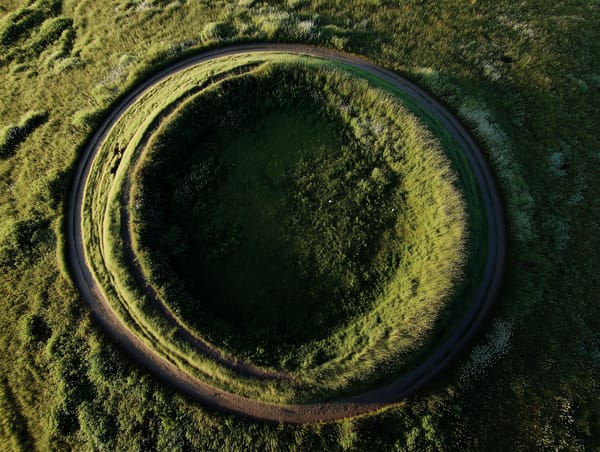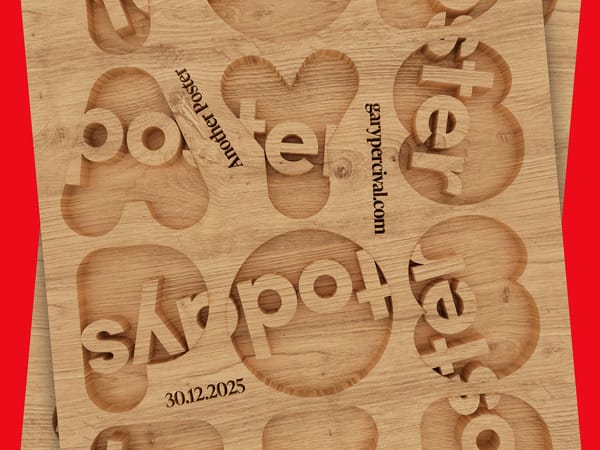Why Your Google Calendar Needs 'Blank Spaces' for Creative Growth
In our modern, bustling lifestyle, the temptation of a full agenda is often irresistible.


In our modern, bustling lifestyle, the temptation of a full agenda is often irresistible.
This is especially true for freelancers, graphic designers, and creatives, who often find themselves juggling multiple projects and deadlines. A fully booked Calendar can give us a sense of accomplishment before the day even begins, serving as a visual affirmation of our productivity and worth.
However, what if this very symbol of "getting things done" is actually doing us more harm than good?
The main argument of this post is both simple and counterintuitive: Over-adherence to routines and meticulously planned schedules can actually stifle our creativity and lead to burnout. While it may seem like filling every available time slot with tasks and meetings is the key to success, this approach often leaves us mentally drained and creatively parched.
In the following sections, we'll delve into why it's crucial to leave 'blank spaces' in your Calendar. These intentional gaps can serve as fertile ground for creative growth, giving you the freedom to explore new ideas, recharge your mental batteries, and ultimately produce better work.
So, if you're ready to break free from the shackles of overscheduling and rediscover your creative spark, read on.
The Illusion of a Full Calendar
The allure of a fully booked calendar is hard to ignore.
Each colour-coded block not only organises our day but also seems to validate our worth, screaming, "You're busy, therefore you're important and successful!" This psychological satisfaction can be a powerful motivator, making us feel accomplished before we've even started our day.
However, this sense of fulfilment is often deceptive and dangerously misleading. A jam-packed schedule can create the illusion of productivity, convincing us that we're making strides in our careers. We feel busy, and in today's culture, busyness is often mistaken for effectiveness.
But here's the catch: Being busy isn't the same as being productive. It's crucial to differentiate between motion and progress. Motion is the act of doing something, but progress is the act of doing something meaningful that moves you closer to your goals.
You might be in motion all day long—answering emails, attending meetings, ticking off to-do list items—but that doesn't mean you're making significant progress, especially in areas that require creative input.
For example, the graphic designer with back-to-back client meetings. These meetings might be necessary, but they also eat into the time that could be spent on actual design work. When do you have the opportunity to sit down, focus, and let your creativity flow?
Or consider the freelancer who's juggling multiple projects. While it might feel like you're climbing the ladder of success, ask yourself: Are you setting aside time to explore new techniques, update your portfolio, or even work on personal passion projects that reignite your creative spark?
A full calendar might look impressive to outsiders and even give you a temporary ego boost, but it's worth taking a closer look. Upon scrutiny, you may find that your schedule is actually a barrier to meaningful work and creative growth. It might be time to rethink how you allocate your time, making room for the activities that truly enrich your professional and creative lives.
The Power of Reflection in Blank Spaces
One of the most overlooked benefits of 'blank spaces' is the opportunity they provide for reflection. In the hustle and bustle of our daily lives, we rarely get the chance to pause and reflect on our actions, decisions, and the direction in which we're headed.
Professional and personal growth can be enhanced through reflection. It allows us to evaluate our choices, learn from our mistakes, and gain clarity on our goals and aspirations. By setting aside dedicated time for introspection, we can gain insights that drive us forward and help us avoid repeating the same mistakes.
Moreover, reflection can be a source of inspiration. By looking back at our past experiences, we can draw connections, identify patterns, and come up with innovative solutions to problems. This process can be particularly beneficial for creatives, as it can lead to fresh ideas and perspectives that might not have been apparent in the heat of the moment.
Embracing the Unpredictable
While it's essential to have a plan and structure in place, there's also immense value in embracing unpredictability.
'Blank spaces' in our calendar give us the flexibility to seize unexpected opportunities, whether it's a last-minute collaboration, an impromptu brainstorming session, or simply a chance to enjoy an unplanned adventure.
Life is full of surprises, and by allowing ourselves the freedom to adapt and change, we can make the most of every situation. This adaptability not only enhances our creativity but also enriches our life experiences.
The Balance Between Structure and Freedom
It's important to note that the advocacy for 'blank spaces' doesn't mean abandoning structure altogether. Instead, it's about finding a balance between having a plan and allowing room for spontaneity.
A well-structured day can increase efficiency and ensure that essential tasks get done. However, interspersing this structure with 'blank spaces' ensures that we don't become slaves to our schedules. It provides a harmonious blend of discipline and freedom, ensuring that while we remain productive, we also nurture our creative spirits.
The Science of Creativity
What is Creativity from a Scientific Perspective?
Scientifically speaking, creativity is not merely an abstract concept or a unique trait of artists and musicians. It represents a cognitive process where individuals generate novel ideas, solve problems, and discern connections that might elude others.
Neuroscience research indicates that creativity involves multiple brain regions. Notably, there's a significant interaction between the prefrontal cortex, which plays a role in planning and decision-making, and the default mode network, associated with self-referential thoughts and daydreaming.
Downtime and Daydreaming: Catalysts for Creativity
One intriguing aspect of creativity is that it often emerges not during active problem-solving but in moments of downtime and daydreaming. During these periods, our brain tends to operate in a kind of "autopilot mode," allowing various neural pathways to interconnect freely, fostering the birth of innovative ideas.
This phenomenon explains why many individuals experience sudden bursts of inspiration during seemingly mundane activities like showering, walking, or even washing dishes.
Value of 'Blank Spaces' in Fostering Creativity
The concept of 'blank spaces' or intentional breaks in our routine, has been highlighted by numerous experts as crucial for enhancing creative thinking.
Boredom, according to Dr Sandi Mann, author of "The Upside of Downtime," can serve as a springboard for creativity. When we are bored, our minds naturally wander, and this mental meandering is often the source of creative insights.
In Summary
The science is clear: Our brains need downtime to incubate ideas and solve problems creatively.
While a packed schedule might give the illusion of productivity, it often robs us of the essential 'blank spaces' needed for genuine creative thinking.
So the next time you're tempted to fill every slot in your Calendar, remember that science advocates for the opposite. Make room for downtime, daydreaming, and those unplanned moments that often serve as the birthplace of your most creative ideas.
The Risks of Over-Scheduling
The dangers of overscheduling go beyond simple inconvenience, presenting significant challenges to both mental well-being and the ability to think creatively.
An overpacked calendar can lead to heightened stress levels as individuals jump from one commitment to another with little time left for essential relaxation and introspection. This constant state of activity can result in both mental fatigue and physical weariness.
Being in a continuous race against time often compromises the quality of one's work. This rush can result in lowered standards, preventable errors, and a discernible drop in creative insight.
Moreover, a jam-packed schedule leaves no room for spontaneity and flexibility, both of which are crucial for nurturing creativity.
In the world of business, there are numerous instances where organisations that provide "free time" or "innovation hours" have observed an enhancement in creative problem-solving among their teams.
In conclusion, the adverse effects of overscheduling are dual-pronged: it not only endangers one's health but also suppresses the creative potential crucial for both personal and professional advancement.
The Benefits of Blank Spaces
The concept of 'blank spaces' refers to intentional gaps or periods of unstructured time in your daily routine.
These could manifest as short breaks between meetings, designated "free time" slots in your calendar, or even entire afternoons left unscheduled.
Firstly, these 'blank spaces' offer fertile ground for increased creativity. When your mind is unburdened by immediate tasks or stressors, it's free to wander and make unique connections. This mental freedom often leads to unexpected insights or bursts of inspiration.
Secondly, incorporating gaps into your schedule can significantly reduce stress. These moments provide mental breathing room, allowing you to approach subsequent tasks with a refreshed and more focused mindset.
Lastly, 'blank spaces' contribute to an improved work-life balance. They give you the flexibility to attend to personal needs, engage in hobbies, or simply unwind and recharge.
Many successful individuals in the creative industry emphasise the importance of downtime. They advocate for periods of rest, relaxation, and inspiration as essential components of their creative process.
In essence, 'blank spaces' are not just empty slots in a calendar; they are vital pockets of opportunity for both personal and professional growth.
Final Thoughts
In a world that often equates busyness with success, it's a radical act to intentionally create 'blank spaces' in our schedules.
However, as we've seen, the benefits of doing so are profound. From boosting creativity and reducing stress to providing opportunities for reflection and spontaneity, these intentional gaps are the key to a more fulfilling and balanced life.
So, as you look at your calendar, challenge yourself to see the 'blank spaces' not as voids to be filled, but as opportunities to be seized. Embrace the potential they offer, and watch as your creativity and well-being flourish.
Conclusion
As we've explored throughout this post, the dangers of overscheduling are real and multifaceted. A cluttered calendar may give the illusion of productivity, but it often serves as a barrier to meaningful work and creative growth.
On the flip side, we've delved into the science of creativity, which clearly shows that our brains need downtime for problem-solving and idea generation. The concept of 'blank spaces'—those intentional gaps in your schedule—emerges as a powerful antidote to the pitfalls of a hectic lifestyle.
These pockets of unstructured time serve multiple purposes: they boost creativity, reduce stress, and improve work-life balance. The evidence overwhelmingly supports the need for 'blank spaces' in our lives.
So, what's stopping you from embracing this transformative practice? There are multiple ways to carve out 'blank spaces' in your day, whether it's by adopting flexible time-blocking techniques or simply saying no to non-essential commitments.
Take action today. Start small if you have to, but start. Your creativity—and your well-being—will thank you for it.



